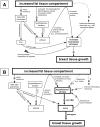Obesity and the pubertal transition in girls and boys
- PMID: 20802107
- PMCID: PMC2931339
- DOI: 10.1530/REP-10-0119
Obesity and the pubertal transition in girls and boys
Abstract
Childhood obesity has become a major health concern in recent decades, especially with regard to metabolic abnormalities that impart a high risk for future cardiovascular disease. Recent data suggest that excess adiposity during childhood may influence pubertal development as well. In particular, excess adiposity during childhood may advance puberty in girls and delay puberty in boys. Obesity in peripubertal girls may also be associated with hyperandrogenemia and a high risk of adolescent polycystic ovary syndrome. How obesity may perturb various hormonal aspects of pubertal development remains unclear, but potential mechanisms are discussed herein. Insulin resistance and compensatory hyperinsulinemia may represent a common thread contributing to many of the pubertal changes reported to occur with childhood obesity. Our understanding of obesity's impact on pubertal development is in its infancy, and more research into pathophysiological mechanisms and longer-term sequelae is important.
Conflict of interest statement
The authors have no conflicts of interest to declare.
Figures


Similar articles
-
Obesity and growth during childhood and puberty.World Rev Nutr Diet. 2013;106:135-41. doi: 10.1159/000342545. Epub 2013 Feb 11. World Rev Nutr Diet. 2013. PMID: 23428692 Review.
-
The association of obesity and hyperandrogenemia during the pubertal transition in girls: obesity as a potential factor in the genesis of postpubertal hyperandrogenism.J Clin Endocrinol Metab. 2006 May;91(5):1714-22. doi: 10.1210/jc.2005-1852. Epub 2006 Feb 21. J Clin Endocrinol Metab. 2006. PMID: 16492701
-
Physical growth and endocrinal disorders during pubertal maturation in girls with epilepsy.Epilepsia. 2004 Sep;45(9):1106-15. doi: 10.1111/j.0013-9580.2004.66303.x. Epilepsia. 2004. PMID: 15329076
-
Puberty and polycystic ovary syndrome.Mol Cell Endocrinol. 2006 Jul 25;254-255:146-53. doi: 10.1016/j.mce.2006.04.028. Epub 2006 Jun 5. Mol Cell Endocrinol. 2006. PMID: 16750596 Review.
-
Hyperandrogenemia in obese peripubertal girls: correlates and potential etiological determinants.Obesity (Silver Spring). 2010 Nov;18(11):2118-24. doi: 10.1038/oby.2010.58. Epub 2010 Mar 25. Obesity (Silver Spring). 2010. PMID: 20339367 Free PMC article.
Cited by
-
Puberty disorders among ART-conceived singletons: a Nordic register study from the CoNARTaS group.Hum Reprod. 2022 Sep 30;37(10):2402-2411. doi: 10.1093/humrep/deac192. Hum Reprod. 2022. PMID: 36029044 Free PMC article.
-
What is the disease burden from childhood and adolescent obesity?: a narrative review.J Yeungnam Med Sci. 2024 Jul;41(3):150-157. doi: 10.12701/jyms.2024.00360. Epub 2024 Jun 27. J Yeungnam Med Sci. 2024. PMID: 38932702 Free PMC article.
-
High Carbohydrate, Fat, and Protein Diets Have a Critical Role in Folliculogenesis and Oocyte Development in Rats.Reprod Sci. 2024 Oct;31(10):3215-3227. doi: 10.1007/s43032-024-01629-1. Epub 2024 Jun 27. Reprod Sci. 2024. PMID: 38937400 Free PMC article.
-
Association of a genetic risk score with BMI along the life-cycle: Evidence from several US cohorts.PLoS One. 2020 Sep 17;15(9):e0239067. doi: 10.1371/journal.pone.0239067. eCollection 2020. PLoS One. 2020. PMID: 32941506 Free PMC article.
-
Social and emotional predictors of the tempo of puberty in female rhesus monkeys.Psychoneuroendocrinology. 2013 Jan;38(1):67-83. doi: 10.1016/j.psyneuen.2012.04.021. Epub 2012 Jun 1. Psychoneuroendocrinology. 2013. PMID: 22658962 Free PMC article.
References
-
- Ahmed ML, Ong KK, Dunger DB. Childhood obesity and the timing of puberty. Trends Endocrinol Metab. 2009;20:237–242. - PubMed
-
- Auchus RJ, Rainey WE. Adrenarche - physiology, biochemistry and human disease. Clinical Endocrinology. 2004;60:288–296. - PubMed
-
- Baillargeon JP, Iuorno MJ, Nestler JE. Insulin sensitizers for polycystic ovary syndrome. Clinical Obstetrics and Gynecology. 2003;46:325–340. - PubMed
-
- Ballerini MG, Ropelato MG, Domene HM, Pennisi P, Heinrich JJ, Jasper HG. Differential impact of simple childhood obesity on the components of the growth hormone-insulin-like growth factor (IGF)-IGF binding proteins axis. Journal of Pediatric Endocrinology and Metabolism. 2004;17:749–757. - PubMed
-
- Biro FM, Khoury P, Morrison JA. Influence of obesity on timing of puberty. International Journal of Andrology. 2006;29:272–277. discussion 286–290. - PubMed
Publication types
MeSH terms
Grants and funding
LinkOut - more resources
Full Text Sources
Medical

